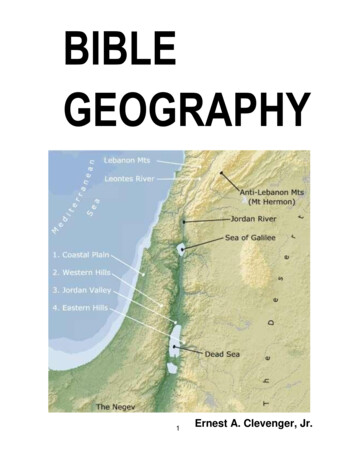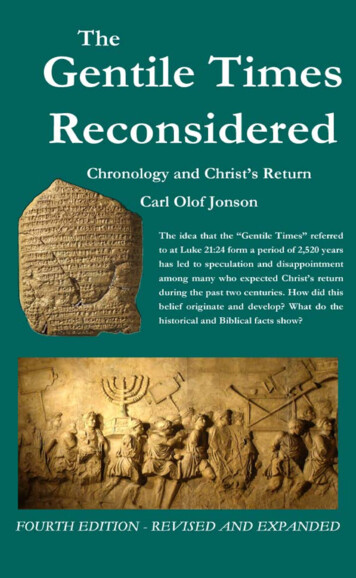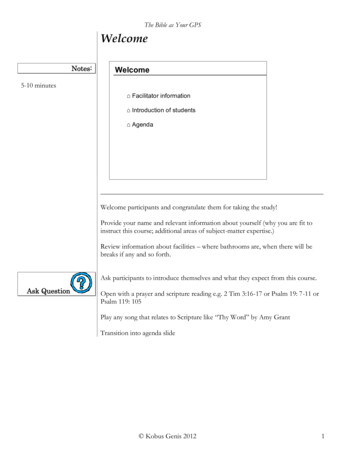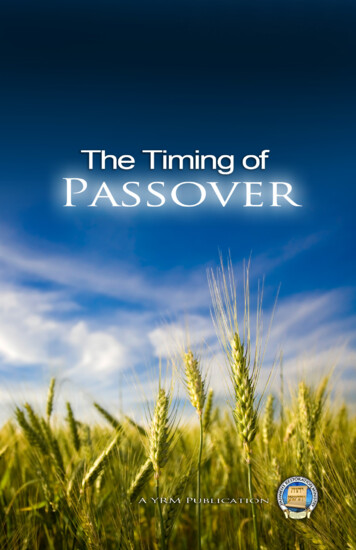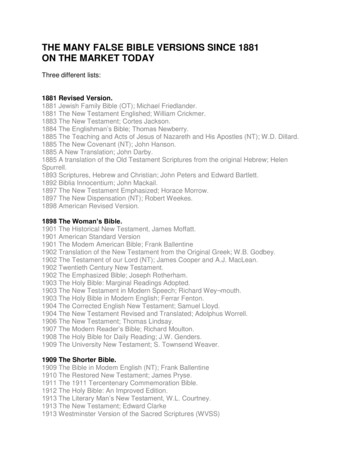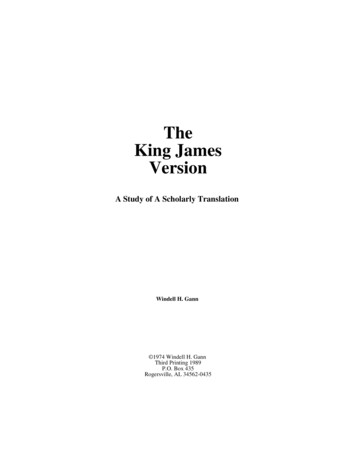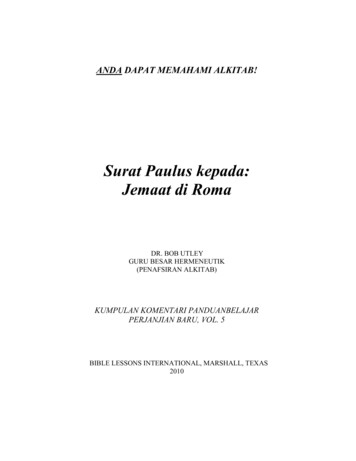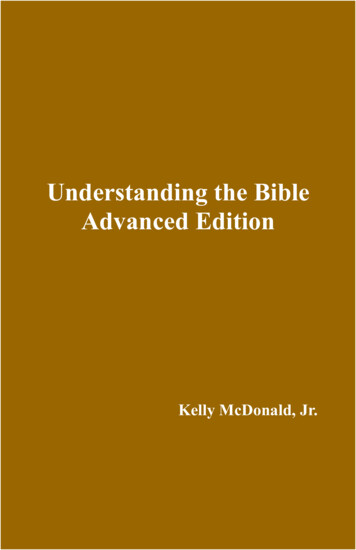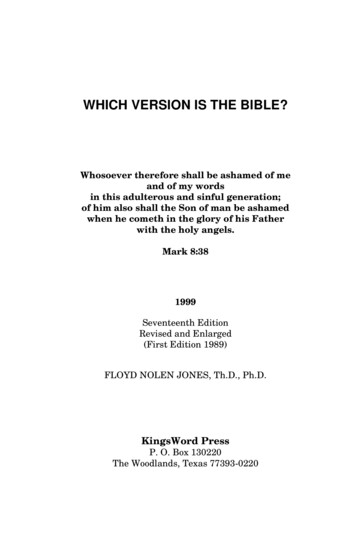
Transcription
WHICH VERSION IS THE BIBLE?Whosoever therefore shall be ashamed of meand of my wordsin this adulterous and sinful generation;of him also shall the Son of man be ashamedwhen he cometh in the glory of his Fatherwith the holy angels.Mark 8:381999Seventeenth EditionRevised and Enlarged(First Edition 1989)FLOYD NOLEN JONES, Th.D., Ph.D.KingsWord PressP. O. Box 130220The Woodlands, Texas 77393-0220
Which Version is the Bible? Copyright 1989-1999 Floyd Nolen JonesFloyd Jones Ministries, Inc.All Rights Reserved. This bookmay be freely reproduced inany form as long as it is notdistributed for any materialgain or profit; however, thisbook may not be publishedwithout written permission.Neither Dr. Jones nor hisfamily receives royalties orremuneration from the saleof this book. Its distributionis not a business venture,it is a ministry.ISBN 0-9700328-0-3
TABLE OF CONTENTSABBREVIATIONS . VI. PRESERVATION OR RESTORATION? . 1THE KEY ISSUE - PRESERVATION. 1SCRIPTURAL JUSTIFICATION FOR THIS STUDY . 4THE ISSUE - JUST WHAT IS AT STAKE? . 5THE ORIGINAL "AUTOGRAPHS" AND "PRESERVATION". 6WHAT DOES GOD PROMISE CONCERNING THE SCRIPTURES? . 8GOD'S METHOD OF PRESERVING THE SCRIPTURES . 10WOLVES PARADING AS SHEEP . 13WHEN DID THE WOLVES BEGIN TO DEVOUR THE WORD?. 13BEWARE - "A LITTLE LEAVEN .". 14NOT AN "AD HOMINEM" . 15THE GREEK STRONGHOLD . 16II. BIBLICAL COMPARISONS DEPICTING THE PROBLEM . 21COLOSSIANS 1:14 . 21FIRST TIMOTHY 3:16 . 21ISAIAH 7:14 . 22ZECHARIAH 9:9. 24MATTHEW 1:25. 24MATTHEW 4:10 (9:18; 20:20; MK.5:6; LK.24:52). 24MATTHEW 6:13. 26MATTHEW 19:17. 27MARK 1:2-3 . 28MARK 9:43-44 . 29MARK 10:21 . 29MARK 16:9-20 . 30LUKE 1:34 . 32LUKE 2:14 . 32LUKE 2:33 . 33LUKE 4:4 . 33LUKE 9:54-56 . 34LUKE 22:64. 34LUKE 23:38. 35LUKE 23:42. 35LUKE 24:6 . 35LUKE 24:42. 35JOHN 1:18 . 36JOHN 3:36 . 38i
JOHN 6:35 . 38JOHN 6:47 . 39JOHN 8:1-11. 39ACTS 8:36-37. 39ACTS 20:28 . 40ROMANS 8:1 . 40ROMANS 14:10B, 12 . 41SECOND TIMOTHY 3:16. 41HEBREWS 1:3. 41HEBREWS 2:11. 42MICAH 5:2 . 42HEBREWS 2:16. 42FIRST PETER 2:2. 45FIRST PETER 4:1. 45FIRST JOHN 5:6-8 . 45ACTS 9:6 . 46PSALMS 8:4-5 . 46III. THE 1881 REVISION. 49A BRIEF HISTORICAL SYNOPSIS . 49WHAT ARE THE MATERIALS AVAILABLE TODAY?. 50BASIC DEFINITIONS . 51ERASMUS RESTORES THE RECEIVED TEXT (GREEK). 52AN ASSESSMENT OF WESTCOTT AND HORT. 54WESTCOTT AND HORT'S INVOLVEMENT IN SPIRITISM. 59AN ASSESSMENT OF ERASMUS. 60IV. THE "TEXTUS RECEPTUS" . 63ERASMUS AND THE WORK HE PRODUCED. 63TYNDALE TRANSLATES THE TEXTUS RECEPTUS INTO ENGLISH . 64LATER EDITIONS OF THE TEXTUS RECEPTUS. 65A BRIEF HISTORY OF THE KING JAMES BIBLE . 66WHAT ABOUT ALL THE CHANGES IN THE KING JAMES BIBLE? . 70WHY THEN ARE NEW TRANSLATIONS THOUGHT NECESSARY? . 77(1) Archaic Words. 78(2) Variant Readings. 79(3) Ancient Greek Manuscripts . 82(4) Winds of Doctrine. 84(5) Greed for Money . 88V. THE GREEK TEXT OF WESTCOTT AND HORT. 91THE MEN WHO CONTROLLED THE 1881 REVISION. 91ORIGEN - THE FOUNTAINHEAD OF THE PROBLEM. 92ii
ORIGEN'S BELIEFS. 94ENTER CONSTANTINE (288-337 A.D.) . 97THE "MYSTERIES" AND THEIR BEGINNING . 98BACK TO CONSTANTINE . 101THE COUNCIL OF NICEA. 102CONSTANTINE COMMISSIONS EUSEBIUS TO MAKE 50 BIBLES . 103THE INQUISITION . 104JEROME AND THE LATIN VULGATE. 105PUT IT ALL TOGETHER, PLEASE . 106VATICANUS B AND SINAITICUS ALEPH . 106ALEXANDRINUS "A" . 108THE SCHOLARS VERSUS JESUS - THE BATTLE CONTINUES. 109THE NESTLE GREEK TEXT . 110THE CANON . 112THE APOCRYPHA. 113VI. HOW HORT SEDUCED THE 1881 COMMITTEE . 119HORT "INVENTS" A HISTORY OF THE BIBLICAL TEXT . 119Genealogical Method. 120Conflation . 122The "Fathers" Letters - External and Internal Evidence . 124The "Early Revision". 125ECLECTICISM AND ITS FRUIT . 127VII. THE HORTIAN-ECLECTIC THEORY REFUTED. 133THE GENEALOGICAL METHOD FRAUD . 133TEXT TYPE "FAMILIES" ARE ARTIFICIAL FABRICATIONS. 136THE QUOTES FROM THE "FATHERS" . 139PAPYRI (C.200 A.D.) SUPPORTS THE TEXTUS RECEPTUS . 142ECCLESIASTIC REVISION? . 144GAIUS, THOUGH LONG DEAD, SPEAKS. 148ARTIFICIAL NATURE OF TEXT FAMILIES DEMONSTRATED . 149ERASMUS VINDICATED . 153ARE THE OLDEST MSS THE BEST? . 155TO WEIGH THE WITNESSES OR TO JUST COUNT THEM?. 159HOW TO EVALUATE THE CREDIBILITY OF A WITNESS. 161WEIGH, BUT THEN COUNT. 162THE IMPORTANCE OF VARIETY IN SELECTING EVIDENCE. 163ANCIENT TRANSLATIONS SUPPORT THE RECEIVED TEXT . 164THE BIBLE OF THE VAUDOIS (WALDENSES). 167THE ORIGINAL TEXT PRESERVED THROUGH THE CHURCH . 170IS NATURALISTIC TEXT CRITICISM SCIENTIFIC?. 174iii
VIII. THE BELIEVING FRAME OF REFERENCE. 181THE CHURCH'S HISTORICAL TEXT. 181THE MODERN VIEW OF INERRANCY AMONG MOST CLERGY . 184HOW PRINCETON WAS CORRUPTED . 186HOW THE CONSERVATIVE SEMINARIES WERE CORRUPTED . 189IX. THE CONCLUSION OF THE MATTER . 195TECHNICAL OVERVIEW. 195HISTORICAL OVERVIEW. 198TEXT CRITICISM TODAY - THE AGE OF MINISCULES . 202CONCLUDING REMARKS . 205APPENDIX A - THE PERICOPE DE ADULTERA . 219APPENDIX B - THE JOHANNINE COMMA . 231APPENDIX C - EXAMPLES OF MODERN CRITICISM . 241APPENDIX D - HISTORY OF TEXTS TRANSMISSION . 257BIBLIOGRAPHY . 263INDEX. 273iv
ABBREVIATIONSAA.D.aAVBb.B.C.BMc.ch.,chs.cp.Dd.ed., eds.e.g.et al.etc.ff.fl.fn.gen. n.d.NIVn.p.Codex AlexandrinusAnno Dei (Year of God)Codex Sinaiticus - pronounced aleph, the 1st letter in theHebrew alphabetAuthorized King James Version (1611)Codex VaticanusbornBefore ChristBritish Museumcirca - about; approximatelychapter(s)compareCodex Bezaediededition(s); editor(s)exempli gratia - for exampleet alii - and otherset cetera - and so forthand the following (verses, pages, etc.)floruit - flourished, used when birth & death dates are notknown.footnotegeneral editoribidem – Latin for "in the same place"id est - that isInternational Standard Bible EncyclopediaKing James Bible (1611)Septuagint, for the "70" (72) translatorsGreek ms of New Testament in small cursive letters. Alsocalled "minuscules".Greek MSS or Codex of the New Testament written incapital letters. Also called "majuscules" and "uncials".A single uncial or cursive manuscript.Masoretic Text, the God given Hebrew Old TestamentNew American Standard Version (Bible) - also shortened toNASThe 26th edition of Nestle's Greek N.T. (same as NestleAland26 or Aland-Nestle26)no dateNew International Versionno place; no publisherv
N.T.op. cit.O.T.p., pp.q.v.rev.rpt.[sic]TRtrans.T.T.UBS3Vid. supraviz.vol., vols.vs., vv.New Testamentopere citato – Latin for "in the work previously cited"Old Testamentpage(s)quod vide - which see (that is, see the preceding item)revision; revised; revised; reviewed byreprint; reprintedso, thusTextus Receptus - the "Received Text". The Providentiallypreserved God given Greek N.T. Synonymous, for practicalpurposes, with "Traditional Text", "Syrian Text","Byzantine", and "majority text" - although this is asimplification.translated by; translator; translationTraditional Text - a text representing the "vast majority ofauthorities"United Bible Society, 3rd edition of its Greek N.T.Vide supra - see above; previous pages or materials in thebook one is reading.videlicet - namelyvolume(s)verse(s)vi
TO THE READER - THE SOUNDING OF AN ALARMIn the King James Bible, Isaiah 14:12, 15 reads:How are thou fallen from heaven, O Lucifer, son of the morning!. Yet thou shalt be brought down to hell.However, the New International Version pens:How you have fallen from heaven O morning star, son of the dawn. but you are brought down to the grave.Indeed, the New American Standard and all the modern versions read almostexactly like the NIV (except the NKJV). Yet historically Isaiah 14 has been citedthroughout the Church as the singular biography and identification of Lucifer[G.A. Riplinger, New Age Bible Versions, (Munroe Falls, OH: A.V. Publications,1993), pp. 40-55]. In verse twelve of the King James, Lucifer is in heaven; inverse fifteen Satan is in hell, and the continuing context establishes that Luciferand Satan are one and the same being. The new versions have removed the name"Lucifer" thereby eliminating the only reference to his true identity in the entireBible – yet the change in these versions is not the result of translation from theHebrew language.The Hebrew here is helel, ben shachar (rj'v;A B, lleyhe@), which translates "Lucifer,son of the morning" (as is found in all the old English translations written before1611 when the KJB was published). The NIV, NASB et al. read as though theHebrew was kokab shachar, ben shachar or "morning star, son of the dawn" (or"son of the morning"). But not only is the Hebrew word for star (bk;/K - kokab)nowhere to be found in the text, "morning" appears only once as given in the KJB– not twice as the modern versions indicate. Moreover, the word kokab istranslated as "star" dozens of other times by the translators of these new "bibles".Their editors also know that kokab boqer (rq,bo bk;/K) is "morning star" for itappears in plural form in Job 38:7 (i.e., morning stars). Had the Lord intended"morning star" in Isaiah 14, He could have eliminated any confusion by repeatingkokab boqer (rq,bo bk;/K) there. God's selection of helel (lleyh, Hebrew for Lucifer)is unique as it appears nowhere else in the Old Testament.Moreover, Revelation 22:16 (also 2:28 and II Pet.1:19) declares unequivocally thatJesus Christ is the "morning star" or "day star" (II Pet. 1:19, cp. Luk. 1:78; Mal.4:2), meaning the sun – not the planet Venus.I Jesus have sent mine angel to testify unto you these things in thechurches. I am the root and the offspring of David, and the bright andmorning star.Thus it must be understood that the identification of Lucifer as being the morningstar does not find its roots in the Hebrew O.T., but from classical mythology andwitchcraft where he is connected with the planet Venus (the morning "star").vii
The wording in the modern versions reads such that it appears the fall recordedin Isaiah 14 is speaking of Jesus rather than Lucifer the Devil! The rendering of"morning star" in place of "Lucifer" in this passage must be seen by the Church asnothing less than the ultimate blasphemy. The NASV compounds its role asmalefactor by placing II Peter 1:19 in the reference next to Isaiah 14 therebysolidifying the impression that the passage refers to Christ Jesus rather thanSatan. But Lucifer (helel, lleyh) does not mean "morning star". It is Latin (fromlux or lucis light, plus fero to bring) meaning "bright one", "light bearer" or"light bringer". Due to the brightness of the planet Venus, from ancient times theword "Lucifer" (helel, lleyh) has been associated in secular and/or pagan workswith that heavenly body.Among the modern versions, only the King James (and NKJV) gives proof thatLucifer is Satan. Without its testimony this central vital truth would soon belost. This fact alone sets the King James Bible apart from and far above allmodern would-be rivals. Truly, it is an achievement sui generis. Indeed, theolder English versions (the 1560 Geneva etc.) also read "Lucifer".The clarion has been faithfully and clearly sounded (I Cor.14:8). If the reader isnot greatly alarmed by the above, it is pointless for him to continue reading.However, if concern has been aroused as to how this deception has been foistednot only upon the Christian Church, but on the general public as well – read on.The story lies before you.Heaven and earth shall pass away: but my wordsshall not pass away.Mark 13:31viii
A BIBLICAL CREDIBILITY CRISISadapted in part from Dr. W.N. Pickering (1990)If we wanted to be certain that a copy of the American Constitution were perfectlyaccurate, we could compare it with the original hand-written document at theNational Archives in Washington, D.C. However, such is not possible with theNew Testament – all of its original manuscripts penned by Paul, Peter and otherapostles in the first century A.D. have disappeared. Nearly all of the copies ofthese originals made during the early centuries thereafter were worn out,destroyed by the Roman Caesars, or remain undiscovered.As a result of the discovery of a number of early manuscripts in the 19th century,questions arose concerning the original wording of the N.T. Although thesediffered significantly in many places from the Traditional Greek text, manyscholars concluded they were better copies of the originals because they were"older". This new approach led to Greek texts based largely upon a handful or aminority of early manuscripts.The original manuscripts of the books of the New Testament were hand copiedover and over again and copies were made from various generations of copies. Asa result, numerous variant readings came to appear in New Testamentmanuscripts. Some of these were merely variations of spelling. Others were farmore serious: (1) additions of words or phrases; (2) omissions of words, phrases,clauses, and whole sentences and paragraphs. These variant readings aroseeither from the inadvertent errors of copyists, or from the efforts of "scholars"(whether well-meaning or otherwise) to correct or even to improve the text.It is the task of textual critics to ascertain just what the original reading was atevery point in the New Testament text where a variant reading exists. This theydo by sifting through a massive quantity of manuscript evidence, supposedly withgreat care. However, there are different schools of thought among textual critics,each with its own set of presuppositions and criteria for evaluating theauthenticity of a reading and the relative importance of a given manuscript.Before accepting the conclusions of a particular textual critic, one should evaluateboth his theological presuppositions and criteria.The New Testaments of the King James Bible, William Tyndale's Bible, Luther'sGerman Bible, Olivetan's French Bible, the Geneva Bible (English), as well asmany other vernacular versions of the Protestant Reformation were translatedfrom the Greek Text of Stephens, 1550, which (with the Elzevir Text of 1624) iscommonly called the Textus Receptus, or the Received Text (TR). It is the"Traditional Text" (T.T.) that has been read and preserved by the Greek OrthodoxChurch throughout the centuries. From it came the Peshitta, the Italic, Celtic,Gallic, and Gothic Bibles, the medieval versions of the evangelical Waldenses andAlbigenses, and other versions suppressed by Rome during the Middle Ages.Though many copies were ruthlessly hunted down and destroyed, the ReceivedText has been preserved by an Almighty Providence.ix
This "Traditional Text" is also referred to as the "majority text",1 since it isrepresented by about 95 percent of the manuscript evidence. This is in sharpcontrast to the Westcott-Hort tradition (which leans heavily on two manuscriptsof the unreliable Alexandrian Text type), the shaky foundation of nearly all oftoday's versions. In the 16th century, Erasmus and the Reformers knowinglyrejected the Gnostic readings of the Alexandrian Codex Vaticanus B and other olduncial (i.e., all capital letters with no spaces between words MSS) manuscripts,whose variant readings they judged to be corrupt. They regarded such dubious"treasures" as the products of scribes who had altered the text to suit their ownprivate interpretations. They also rejected Jerome's Latin Vulgate as a corruptversion and as an improper basis for vernacular translations.The earliest known portion of the N.T. is Papyrus P-52 (until 1995 when theMagdalen Papyrus was dated as A.D. 66 & found to contain TR/KJB readings!See p. 207). Also known as "John Rylands Greek 457", this 2.5 by 3.5 inchfragment is usually dated about A.D. 125 and contains John 18:31-33, 37-38. Theearliest extant copy containing a complete book is Papyrus 72. Dated around 300,it contains all of I and II Peter and Jude. About 70 Greek MSS have beenassigned a date earlier than 400 A.D., but almost all of them are veryfragmentary. Where these do overlap, significant disagreement is usually foundamong them as to the correct wording. Around 190 Greek copies have been datedbetween A.D. 400-800. Most of these are also fragmentary, and they differconsiderably where they overlap. As of 800 A.D., only eight extant Greek MSScontain all four gospels in essentially their entirety. Of these, only five contain allof Acts, five all of Romans and two all of Revelation.Of the 3,000 plus Greek manuscripts of the N.T., about 1700 are from the 12th14th centuries. They, along with 640 copies from the 9th - 11th centuries, are inbasic agreement on approximately 99% of the words of the N.T. As a group,however, this majority disagree considerably with most of the copies from theearly centuries – which also differ considerably among themselves. This, then, isthe situation that has given rise to the debate over the original wording of theNew Testament. Nevertheless, despite all the variations, nearly all of the wordsof the N.T. enjoy over 99% attestation from the extant Greek MSS/mss. Onlyabout 2% have less than 95% support and fewer than 1% of the words have lessthan 80% (and most of these differ only slightly).Yet for the past 100 years, the world of scholarship has been dominated by theview that this majority text is a secondary and inferior text. Scholars haverejected that we have had the true text of the originals all along and have thusattempted to reconstruct the original text of the N.T. on the basis of the few1Recently, several Greek N.T.'s have been published under the designation "MajorityText". Hence, in this work the term "majority" is capitalized when referring to a singleentity but is left in small letters when the word "majority" is intended with regard to thewhole body of extant Greek manuscripts (i.e., as opposed to the "minority" of the mss).x
early manuscripts. But as these copies differ considerably among themselves, theresult has been an eclectic "patchwork quilt". The editors of the dominant eclecticGreek text of today have usually followed a single Greek MSS and in dozens ofplaces they have printed a text not found in any known Greek copy! Thediscrepancy between this eclectic text and the majority reading is about 8%. Thatwould amount to 48 full pages of discrepancies in a 600 page text. Around 1/5 ofthat represents omissions in the "minority text" such that it is about 10 pagesshorter than the majority text. Nearly all modern versions of the Bible are basedon this "minority text" whereas the King James is based on an identical twinbrother of the "majority text". This is why so many verses, phrases, etc. familiarto users of the KJB are missing in the modern versions.The question is which of these two Greek texts is the Word of God? There are anumber of reasons for rejecting these early MSS as spurious. An inquiry revealsthat the "majority text" has dominated the stream of transmission down throughthe centuries because the Church considered it to be the God given text. It hasthe greatest geographic distribution as well as the longest continuity throughouttime. The "minority text" never circulated widely within the Church, and itvirtually disappeared after the 4th century. Further, they have few directdescendants, demonstrating that they were rejected in their day – not deemedworthy of copying. The undisputed fact that the early minority copies not onlydiffer from the majority but also differ significantly among themselvesundermines their credibility as valid witnesses to the true text.It is often stated that no matter what Greek text one may use no Christiandoctrine is actually affected, hence, the whole controversy is but a "tempest in ateapot". Not so, for although as many as half of the differences between the"majority" and "minority" texts be termed "inconsequential", about 25 pages ofsignificant discrepancies remain – and the "minority" omits words from the textthat total 10 pages.Moreover, the "minority text" has introduced some unequivocal errors whichmake the doctrine of inerrancy indefensible. For example, Matthew 1:7 and 1:10list Asaph and Amos, two non-existent kings, in Christ's genealogy whereas theTraditional Text correctly reads "Asa" and "Amon". Luke 23:45 has a scientificerror in the Minority reading. Here it is stated that the sun was eclipsed (Gr.eklipontos) at Christ's death, but this is impossible as the Passover always occursduring the time of the full moon. An eclipse of the sun can occur only during thenew moon phase. The T.T. reads "the sun was darkened" (eskotisthe). TheMinority Text of John 7:8 relates Jesus' telling his brothers that He is not goingto the feast; then two verses later, He goes. No contradiction exists in the T.T.which records Jesus as saying "I am not yet going."The result of this is that although most major Christian doctrine is not at risk(though several such as eternal judgment, the ascension and the deity of Jesusare significantly weakened), two are. Total havoc is played upon the doctrine ofxi
Divine Inspiration due to the plain errors of fact and contradictions incorporatedin the eclectic te
ISBE International Standard Bible Encyclopedia KJB/KJ King James Bible (1611) LXX Septuagint, for the "70" (72) translators mss Greek ms of New Testament in small cursive letters. Also called "minuscules". MSS Greek MSS or Codex of the New Testament written in


